Nowadays thanks to Disney Pixar’s film Finding Nemo everybody knows the clownfish, also called anemonefish. Although the film has some basic mistakes, actually Nemo, the clownfish, can be found in shallows waters of the sea, he is real, and like in the film, he is really special. Indeed, clownfish get their name from their bright colors and their behavior.
Clownfish
Anemonefish belong to the family Pomacentridae or damselfish. Damselfishes are small, in the main less than 15 cm, but they are abundant and diverse with well over 300 species throughout the tropical shallows waters, mostly on Indo-Pacific reefs. Some damselfish graze from algae, while many others feed on zooplankton and are omnivores.
The major difference between clownfishes and the rest of the damselfish is the special relationship between clownfish and their hosts anemones. Dr C. Collingwood in 1868 was the first scientist who reported a note about these incredible fishes and their astonishing relationship with some anemones, observed in shallow waters of Borneo. There are about 28 species described, along with ten species of anemones that act as hosts. All of the fishes belong to genus Amphiprion, except Premnas biaculeatus or the spine-cheek anemonefish. Some speci es of clownfishes can live with several different anemone species whereas others are restricted with one particular host. Many large anemones are quite capable of living without clownfishes, but the fishes are so dependent on the protection of their hosts that they are always found living with anemones in their natural environment. Although they can be kept in an aquarium without it, without anemones clownfishes are quickly eaten by predators. Anemonefish live in coral reef shallow tropical waters. They can be found in India, Indo-Pacific Ocean, and Japan, but the richest waters are at New Guinea.
es of clownfishes can live with several different anemone species whereas others are restricted with one particular host. Many large anemones are quite capable of living without clownfishes, but the fishes are so dependent on the protection of their hosts that they are always found living with anemones in their natural environment. Although they can be kept in an aquarium without it, without anemones clownfishes are quickly eaten by predators. Anemonefish live in coral reef shallow tropical waters. They can be found in India, Indo-Pacific Ocean, and Japan, but the richest waters are at New Guinea.
Sea Anemones

Anemones were thought to be plants because of their appearance that can be confused with flowers. But they are animals, invertebrates belonging to the order Actinaria, from class Anthozoa as corals, and phylum Cnidaria as jellyfish, box jellies, hydras, corals or tube-dwelling anemones. Cnidarians are relatively simple animals found exclusively in aquatic environments, principally in the sea. An anemone is basically a typical polyp, a small sac attached to the bottom by an adhesive foot. The sac is a gastrovascular cavity with a single opening to the outside that functions as both a mouth and anus. Anemones are diplobastics; that is, the gastrovascular cavity is surrounded by two cell layers, the endoderm or gastrodermis and the ectoderm or epidermis, and between them there is the mesoglea, that can not be considered as cell layer. The mouth is surrounded by tentacles. In the epidermis there are different kind of cells like epithelium-muscular cells, glandular cells, sensorial cells and cnidocytes, and in the gastrodermis nutritive-muscular, glandular and enzymatic cells and cnidocytes are common. Cnidocytes, very typical cells of Cnidarians, are specialized cells that carry organelles capable of expelling and are used to catch a prey or to defend themselves from predators. Cnidocytes have an organelle called nematocysts that contains a toxic – a poison substance that paralyses the prey. Each nematocyst contains a small vesicle filled with toxins and an inner long filament as a harpoon with thorns or hooks. When the cell is touched it mechanically triggers the cell explosion that fires the harpoon-like structure, which attaches to animal flesh and injects a dose of poison in the aggressor or in the prey. The poison is actually a mix of toxins including neurotoxins, which serve to paralyze and capture the prey, which is then moved by the tentacles to the mouth for digestion inside the gastrovascular cavity. This toxin has been reported as highly toxic to fish and crustaceans, their natural prey.
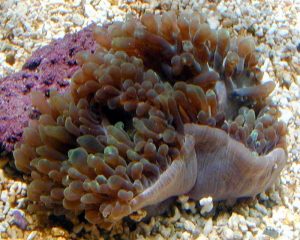
Anemones, as almost all cnidarians, are carnivorous and feed on the animals that stick on their tentacles. But many sea anemones have a symbiotic relationship with microalgae, dinoflagellates, called zooxanthellae, that live in the anemone’s gastrodermal cells. So the anemone benefits from the products of photosynthesis like oxygen and organic products as carbon hydrates while the zooxanthellae get protection and a reliable exposure to sunlight.
While Cnidarian’s typical life cycle integrates two stages, the sexual free-swimming medusa and the asexual polyp, sea anemones entirely lack the medusa stage and the polyps spawn through the mouth freely into the sea where fertilization occurs and the fertilized eggs develops into a planula larvae that develops directly into another polyp. Normally the sexes in sea anemones are separate and both, sexual and asexual reproductions occur. Asexual reproduction occurs by budding, binary fission and fragmentation of the basal disk in which small pieces of the pedal disc break off and regenerate into small anemones.
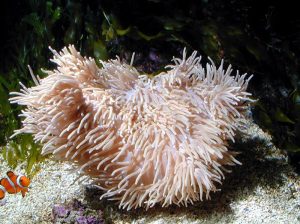
Symbiosis and clownfish
Some sea anemones form symbiotic relationships with crabs, shrimps or clownfish. This means they benefit from living with the sea anemone and the sea anemone benefit for their presence. In the first case, anemones will live attached to the shell of a hermit crab providing additional protection for the crab and allowing the anemone to eat scraps when the crab feeds and moving when the crab does, even when the hermit changes to a new larger shell the crab also moves the anemones to this new shell. Even some crab species carry the anemones in their claws and use them as protection when a fish comes too close. Anemones also provide clownfish with a safe refuge, and the fish drive away butterfly fishes that eat anemones, and they may clean away debris and parasites from anemone and fed it too. An anemone will often have several fish living in association with it. Normally the largest fish in the group is always female, the next is a mature male, and smaller fishes are immature males. If an accident happens and the male dies, the next male in line become sexually mature and substitutes him in the couple, but if it is the female who dies, the male changes sex and replaces her, and then the stronger immature male matures and takes his place. This happens because clownfishes are protandrous hermaphrodites, meaning that when an anemonefish hatches both get immature sexual organs. The male organ matures first, later it degenerates and female sexual organ matures and then the fish becomes female. These changes are irreversible.
Although sea anemones can kill other fish that touch them, clownfish seem immune to the poison. Their immunity is not well understood but actually there are some different theories. In fact anemonefish are not immune, and if they are apart from their anemone they can lose their immunity. Clownfish are protected against the anemone’s sting by their mucus coating; that is, they have evolved to have mucus chemistry that does not stimulate the nematocyst’s discharge. A popular theory is that the fish acquires the mucus from the anemone as they live among anemone’s tentacles they attach some of the anemone’s mucus to their body. An alternative suggestion is that the immunity is an adaptation of the fish’s own mucus. Whatever it will be, a substance in the mucus coating of the fish acts in a similar manner to the anemone’s own protection against stinging itself.
The spawning season of clownfish is year around in tropical water and in nature it seems to be linked with the lunar cycle. Once the anemone fish couple is formed it can last for several years. Males attract the femalesby courting, that includes dancing in front of the female, biting and extending fins. Then the male and also the female will start to clean a patch of rock at the base of their host sea anemone. The female’s abdomen will bulge with eggs and both male and female will show their genital tubes. Spawning begins when the female swims over the cleaned rocks and deposits the eggs in small lines through the ovipositor, and then the male follows her and fertilises them. The male will guard and protect the eggs until they hatch, being aggressive with intrusive, separating dead eggs to avoid fungi growth, and also preventing algae from growth and removing debris, fanning them with both mouth and fins. Meanwhile the female will take care of the host sea anemone.
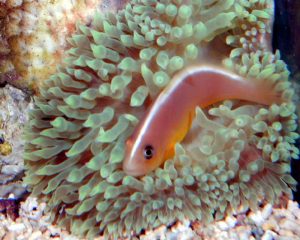
Reproduction and rearing in captivity
At Abra Aquarium facilities Amphiprion ocellaris reproduction has been carried out with success. Once the ocellaris clownfish couple was obtained, introduced and settled into their new home, that is, their new show tank, with a sea anemone if possible, it is time to wait patiently for the fish to spawn. In our case, the ocellaris clownfish’s host anemone was an Heteractis magnifica. For good quality eggs an adequate alimentation of the genitors is need. We feed the fish with a varied diet that consists in frozen and live artemia, dry pellets, frozen shrimps, frozen white fish, frozen mussels, frozen squid and frozen spinach.
The first indication of possible spawning was when the courting began. The male started to dance up and down in front the female. At that moment both male and female began to clean the rock close to the host sea anemone. They finally showed their genital tubes, which means that spawning will happen soon. Finally, at midday, the female swam over the cleaned patch rock and began to lay eggs in small lines, and the male followed her and fertilized the eggs. This process took some hours and finally a bright orange patch that contained about 200 to 400 eggs was observed on the rock. Once the first spawning had taken place, it was repeated at intervals of about 18 to 20 days.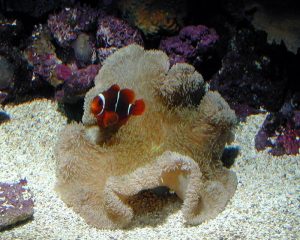
The eggs looked like little capsules about 2 to 3 mm long and 1 mm wide. They were widely stuck on the rock by a flexible stem called manubrio. Their typical orange colour is due to the egg vellum. As the embryo grow up, the eggs began to get dark because the vellum is consumed. One day prior to hatching the eggs developed a silver colour and the larvae and their eyes were visible. In our case, the eggs took about 8 to 10 days to hatch, depending on temperature. The hatch took place during the night and larvae tended to go to the surface.
In captivity, our case, we removed the eggs on the rock to a rearing tank, to avoid larvae been eaten by clownfish’s tank mates. We took the rock upon which the eggs were laid when the eggs developed a silver colour, one day before the eggs’ hatching. We alw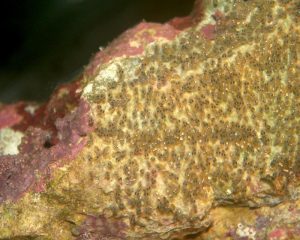 ays kept the eggs under water, and the water of the rearing tank was from the spawning tank as differences in water quality parameters could damage the eggs. Once the eggs in their new container, we provided them with sufficient water current using an air stone. When the eggs hatched we removed the rock and we put it in the previous position, for the couple to hatch there again. We decided that our rearing tank had not recirculation water and so we provided the tank with air stones and we made partial water changes, at least until larvae were enough developed, when a biofilter and recirculation water were set up. The first two days, to avoid larvae stress, the tank was in darkness, and lighting was added little by little in the following days, using fluorescent light.
ays kept the eggs under water, and the water of the rearing tank was from the spawning tank as differences in water quality parameters could damage the eggs. Once the eggs in their new container, we provided them with sufficient water current using an air stone. When the eggs hatched we removed the rock and we put it in the previous position, for the couple to hatch there again. We decided that our rearing tank had not recirculation water and so we provided the tank with air stones and we made partial water changes, at least until larvae were enough developed, when a biofilter and recirculation water were set up. The first two days, to avoid larvae stress, the tank was in darkness, and lighting was added little by little in the following days, using fluorescent light.
Once the larvae had hatched it was time to start rearing them. Although with circular tanks it is said to get best results we used rectangular tanks of 60 litters. Clownfish’s larvae is larger than other sea fish species’ larvae, and they hatch more developed. Anemone fish larvae have a yolk sac that provides them nourishment for at least 12 hours. Since they hatch at night, we added live food in the morning. At that moment the mouth is opened, eyes dark and larvae are ready to be fed, a huge difference from other sea fish species that need some days to develop and ready to be fed, as sea bream or sea bass. In nature, larvae feed on marine plankton. In captivity we used rotifers (Brachionus plicatilis). Rotifers are microscopic animals that are part of natural marine plankton, and due to their size and their relative easy culture they are widely used in marine aquaculture.
We used the “green water” method to rear the larvae. In this case phytoplankton is added to the rearing tank. Microalgae contributes to the development of the larvae: whether it’s the darkened tank and avoiding larvae light stress, or improving water quality, or because the microalgae is said to be antibacterial or even allows the rotifers to continue with enrichment until eaten by the larvae. Although to add rotifers during 12 days is enough we added them during 25 days to allow the smallest larvae to be fed. With the larvae grown, about day 5, we began to add naupli of artemia, along with rotifers, and little by little bigger sized artemia were added. Finally dry food can be added, always in combination with rotifer and artemia until the larvae are able to eat dry food without problem, about one month later. We wanted to have a rotifer density of about 15 rot/mal and 0.75-1 artemia/ml in the raring tank to ensure that the larvae will have a better change of catching their prey.
During this period the rearing tank should be kept clean with the bottom siphoned of dead larvae, detritus and faeces. During the first two days we did not replace the water, but then water changes were carried out everyday at a rate of 10% and after day 12 the changes were carried out every two days at a rate of 30%. The replacement water was of the same temperature, salinity and pH to reduce shock in larvae.
For the first two days we had some mortality. From day three to seven larvae grew very quickly, and were eating actively. Until this moment larvae were small and transparent without the characteristic colour of their parents. But at day nine metamorphosis began, and they started to look like adults. Larvae began to develop a white stripe near the head and the body started to darken. At day 13 the white stripe in the middle of the body appeared, and at day 17 their pectoral fins started to appear, and the larvae seemed to have “black shoes.” Later on they got their adult appearance. During this metamorphosis mortality also was high.
Critical stages are the two first days of larvae life and the moment metamorphosis takes place, when mortality can be high. At those two times we tried to avoid additional stress, adequate food was added and water changes were reduced to a minimum. During metamorphosis we added some false anemone to improve their chances. We made the artificial anemones by joining small pieces of aeration tubes with an elastic band.
Once larvae became juveniles we moved them to another tank with some real sea anemones. At that moment all of them were immature males. But when the strongest one found a free sea anemone he settled there and become a female, and then the next in hierarchy matured to a male and a new couple was formed. So the new life cycle began again.
Bibliography
- Ballesta, Laurent; Descamp, Pierre. 2005. Planète mers. Voyage au coeur de la biodiversité. Éditions Michel Lafon.
- Barnes, R.D. 1983. Zoología de los invertebrados. Nueva Editorial Interamericana.
- Bengoa Ruigomez, M.V. 2005. Nemo tiene familia numerosa. Buceo XXI, No 53.
- Buttfield, Helen; Abrams, Harry N. 1991. The secret life of fishes. INC, Publishers.
- Fautin, Daphne G.; Allen, Gerald R. 1997. Anemonefish and their host sea anemones. Western Australian Museum.
- Grassé, P.-P.; Poisson, R.A.; Tuzet, O. 1985. Zoologia, 1. Invertebrados. Ed. Masson.
- Hoff, Frank H. Jr. 1996. Conditioning, spawning and rearing of fish with emphasis on marine clownfish. Aquaculture Consultans Inc.
- Mojetta, Angelo. 2006. Guía del mundo submarino. Barrera coralina. (The coral reef. Underwater world). LIBSA.
- Pitkin, Linda. 2001. Coral fish. The Natural History Museum, London.
- Sprung, Julian; Delbeek, Charles. 1997. The reef aquarium. Ricordea Publishing.
- Thresher, R:E: 1984. Reproduction in reef fish. T.F.H. Publication.
- Wilkerson, Joyce D. 1998. Clownfishes. Microcosm Ltd.
- Wu, Norbert. 2000. Tesoros del mar. Ed. Könemann Kerlagsgesellschaft mbH.


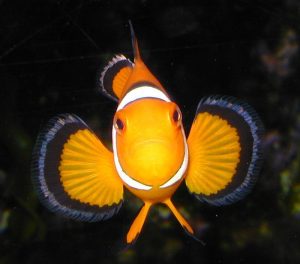
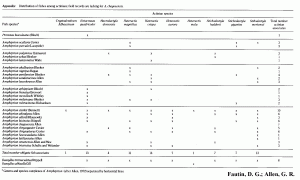

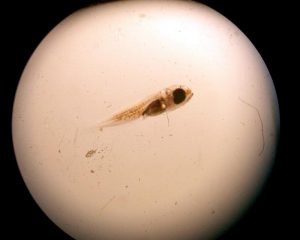

0 Comments